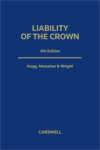
Liability of the Crown 4th Ed
|
Book $399.00 RRP |
Date: 30/08/2011 Code: 9780779836352 Carswell, Canada |
 Liability of the Crown 4th Ed
Price: $399.00
|
Available Formats
| Format | Title | Date | Code | Price | |
|---|---|---|---|---|---|
| Book | Liability of the Crown 4th Ed | 30/08/2011 | 9780779836352 | $399.00 |
Add to cart
 Liability of the Crown 4th Ed
Price: $399.00
|
Description
With government now having assumed an important role in most areas of economic and social life, issues relating to potential legal liability for wrongful or negligent activity have taken on increasing importance. When things go wrong, whether it involves matters as diverse as problems with the blood supply, with unsafe drinking water, or the failure of a major financial institution, those who suffer loss inevitably look to whether their losses can be traced back to government or regulatory failure.
This 40th Anniversary Edition has been re-written to take account of the numerous significant developments in the field. New chapters on restitution, taking (expropriation), trust, estoppel and Crown as creditor have been added, together with a concluding chapter which draws together a coherent thesis for the book.
Jurisdiction: Canada
Editorial Reviews
From: Bar News - Summer 2011/2012
Reviewed by Justice Alan Robertson
It is 40 years since the first edition of Liability of the Crown. It covered Australia, New Zealand and the United Kingdom. Earlier editions were, I think, influential in the move from Bradken consolidated Ltd v Broken Hill Pty Co Ltd (1979) 145 CLR 107 to Bropho v Western Australia (1990) 171 CLR 1 and NT Power Generation Pty Ltd v Power and Water Authority (2004) 219 CLR 90. Earlier editions were often cited in Australian courts, with greater approval as time went on.
The fourth edition is restricted to Canada, although the authors make reference to the law of Australia, New Zealand and the United Kingdom. The focus of the book, say the authors, is the extent to which the Crown, in the sense of the executive branch of government, is liable to pay damages or give other redress to persons injured by the exercise of government power. But that description does not adequately describe the depth of principle from which that issue is addressed nor the width of the subject matters that are considered.
A list of just the new or rewritten chapters – tort, contract, restitution, trust, estoppel, procedure, evidence, expropriation and the Crown as creditor – indicates the scope of the book and how it has expanded since earlier editions.
The authors’ view is that the executive branch of government (the Crown) ought to be governed ‘as far as possible’ by the same rules of legal liability for harm caused to private persons as is a private person. The similarity of this language to the terms of section 64 of the Judiciary Act 1903 and equivalent provisions in the Crown proceedings legislation of some of the states will not escape the attentive.
"The focus of the book, say the authors, is the extent to which the Crown, in the sense of the executive branch of government, is liable to pay damages or give other redress to persons injured by the exercise of government power."
The early chapters of the book, dealing with remedies against the Crown, relate (with approval) the gradual assimilation of the Crown to private defendants and criticise the few immunities (used in a very general sense) of the Crown that persist.
Of interest to Australian public lawyers is the discussion of the recent decision of the Supreme Court, Canada (Attorney General) v TeleZone Inc [2010] 3 SCR 585 rejecting any prohibition on
‘collateral attack’ and holding that the plaintiff suing the Crown for damages in tort was entitled to have the claim disposed of in a single proceeding, as would be the case if the defendant were a private person.
Also of interest is the decision in Kingstreet Investments Ltd v New Brunswick (Finance) [2007] 1 SCR 3 dealing with the entitlement of the taxpayer to a remedy in restitution to recover money paid as tax where the tax is subsequently found to be unconstitutional.
Also of interest is the decision in Kingstreet Investments Ltd v New Brunswick (Finance) [2007] 1 SCR 3 dealing with the entitlement of the taxpayer to a remedy in restitution to recover money paid as tax where the tax is subsequently found to be unconstitutional.
The authors note the ‘melancholy history’ of the special rule that the Crown is not bound by a
statute except by express words or necessary implication and with sadness note that it continues to be the law of Canada, except in two provinces, British Columbia and Prince Edward Island. Bropho is noted as ‘a modest and incremental judicial reform’.
It is a pity that the incisive thinking which informs this book is no longer directly concerned with Australia. I echo Professor Harry Whitmore’s review of the first edition when he wrote in the Federal Law Review in 1972: On reading this book I am filled with regret that one of our leading public lawyers, Peter Hogg, has left Monash University to take up a chair in Canada.
Nevertheless it is of great interest to see what development has been made in Canada in emythologising the Crown and to note what, in the authors’ view, remains to be done.
 Government
Government